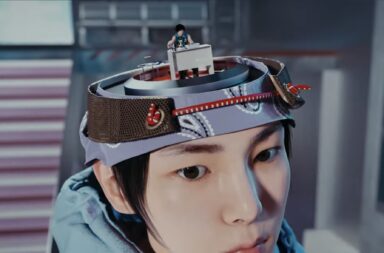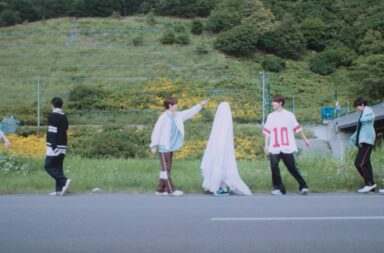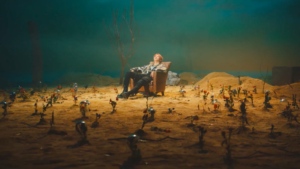
In their first outing as a five-piece group (following the departure of Heochan for a DUI violation), Victon are facing multiple challenges. Aside from the obvious questions of how to regroup and reorganise, the style of the music will always come into a renewed focus, along with questions about to how continue with any storylines or lore.
Victon rise to these challenges in “Virus” with an efficacy and slickness that one would expect from a 3rd generation group that has been around since 2016. The song and the MV ultimately lacks the innovative, funky edge of their previous title track “Stupid O’clock”, but there is enough melodic and visual play to keep the group moving forward.
The song opens with the single notes of a synth playing an almost delicate melody, before morphing into the more typical background grind. This melody repeats across the chorus, in a sort of battle with the darker, deeper sounds of the verses. This isn’t a complete flip in tone or style, but provides enough of a contrast to form the background of the song.
To compliment this musical differentiation, the MV plays with a lot of visuals that place the natural and artificial together. Byungchan stumbles through everyone’s favourite dark-concept backdrop, the desert, but with huge white sheets fluttering above him like laundry. Seungsik reclines on a leather armchair in the same arid scene, but surrounded by roses in bell jars. He also sits in an enclosed, dark green-walled space covered in multi-coloured flowers. Subin appears in a similar space, his room instead being covered in overgrown moss, complete with dancing ceiling light that seems to be coming through water.
The effect of these visual contrasts is jarring, and yet always aesthetically pleasing. The prettiness of these scenes is always paramount, rather than giving any kind of exploration to the weirdness of these scenarios. Whilst “Stupid O’clock” was not afraid to be fairly daring in a lot of its compositions, here, it is all overtly artistic. Gone is the wooziness and abundance of shadows, replaced by more obvious sets and more straightforward cinematography.
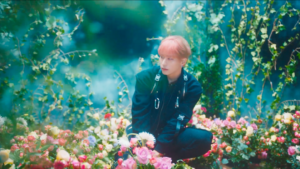
This aestheticism mirrors the style change of the song from the previous track to now as well. Whilst there is a lot of growl to the electronic synths underpinning the song, the delicate melody is never far away, and thus neither is the delicacy of flowers, roses, and sheets flying in the wind. “Virus” is ever-so-slightly lighter in tone than “Stupid O’clock”, and the settings reflect this skilfully.
This lightness of touch in the settings seems to echo the song’s lyrics too, though the metaphors here are little bit more overt. The song plays a lot with ideas of beauty mixing with darkness, not least through the chorus that links love to a virus.
I can go, even it hurts, it’ll be you
My choice is always love like virus
There are also ample descriptions of beautiful scenes with negative undertones throughout.
You’re the most splendid tragedy in the world
Under the diamond sky
It’s so bright that makes me blind
It would be too overt to put these metaphors literally on the screen, making it a smart choice to extrapolate the beauty/darkness concept onto other settings. However, in these lyrics, there is a greater sense of drama than perhaps comes through in these pretty visual moments.
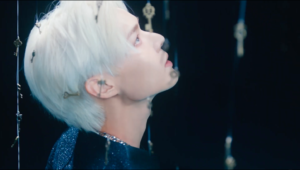
That isn’t to say that there is no drama or innovation at all at play, especially if we return to the MV’s cinematography. In clear nods to “Stupid O’clock”, there are a few shots that are flipped upside down, and Byungchan even gets a scene among flaming vats of petrol. We also see nods to the pocket watch of the last MV (Subin and Seungsik both hold it at different points) and keys, beautifully arranged in a scene cascading around Sejun. These moments are only referential and thus brief, but they are here.
The drama also comes from the beauty of several shot compositions, such as Subin falling into a shallow concrete pool of water, shot directly from above with moss creeping up around him. It is a subtler style of filming, and may not entirely match the dichotomy presented in the lyrics, but it is engrossing nonetheless.
There is one moment in the MV, however, that does jump feet-first into this duality motif. When Hanse begins his rap section after the first chorus, he is filmed in a dark, angular frame, brightly lit from above. Whilst his figure largely remains still in the centre of the scene, a second Hanse walks tauntingly around him, rapping the words as his double stands emotionless. He is clearly having immense fun playing the devious trickster to his own sullen counterpart, and it elaborates the feeling of being “possessed” that he raps about in his verse.
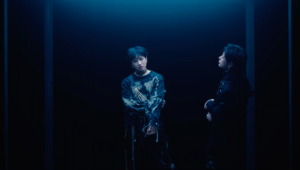
Perhaps because his section of the MV is the most playful, Hanse also gets the most exciting styling of the MV. Given that this song is a softer, yet darker song than its predecessor, the colours at play are generally less bold, with flashes of colour rather than blocks. The members’ hair is less bright, with coloured highlights featuring on Subin and Byungchan, whilst Seungsik and Sejun have the softer colours of coral and blonde respectively, leaving Hanse with the classic black. Hanse’s playfulness comes in through his makeup, featuring bleached blonde eyebrows and a dusting of dark red eyeshadow. The overall look is, again, a nice play on contrasts, and adds another subtle, yet distinctive touch.
It is perhaps a little disappointing that more ideas of contrast fail to shine through in the outfits of the MV, though the final dance sequence does see all the members dressed in white suits with—at this point, standard issue—black harnesses. The brightness of this group look stands out boldly against the darker, more muted and casual pieces the members have worn throughout the MV, and it is a smart choice to flash it through the MV’s final section, though it might have been fun to see it woven in just a little bit more.
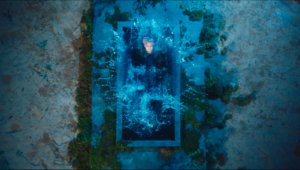
Ultimately, what comes across in “Virus” is a Victon looking to take a more subtle approach to the concepts of their songs. This has created an MV littered with visually arresting scenes, and a real sense of control over exactly how to present their metaphors. However, as a follow-on from “Stupid O’clock”, it does lack a little bit of structural innovation, a sense of play that we only really see from Hanse. It is a solid next step for Victon at their smallest size, and could lead to ever more exciting work if they can continue to perfect the balance of creativity and subtlety.
(NME, YouTube. Lyrics via Genius. Images via IST Entertainment.)

